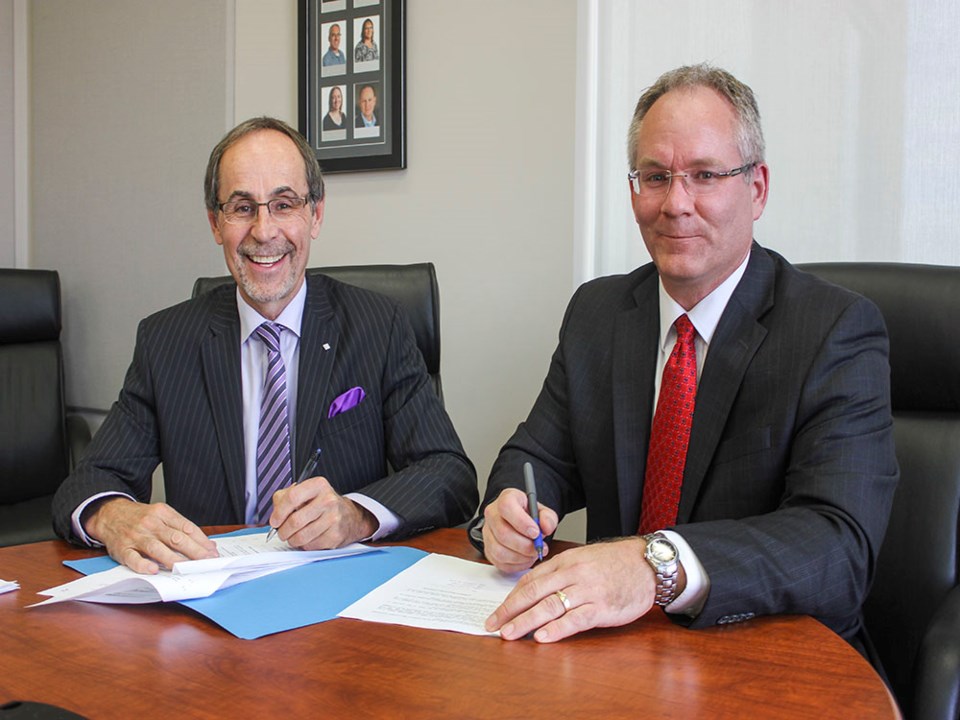Southeast College and Saskatchewan Polytechnic have reached an agreement that creates new and enhanced skills training opportunities for students in southeastern Saskatchewan – an arrangement that is the first of its kind in the province.
The two sides announced the pact on Sept. 30 at the college’s Saskatchewan Energy Training Institute (SETI) in Estevan. Southeast College president and CEO Dion McGrath, and Dr. Larry Rosia, who holds the same duties with Sask. Polytechnic, participated in the signing of the memorandum of understanding.
As part of the arrangement, the two institutions will share their knowledge and resources to train additional skilled workers, so they can fill labour shortages in industries such as energy and mining.
“Meeting the needs of students and meeting the needs of employers are two of Saskatchewan Polytechnic’s top priorities,” said Rosia. “We want to make sure our students succeed, and we want to provide skilled graduates for the labour market.”
Rosia said the arrangement allows Sask. Polytechnic to do a better job of getting their name out across the province. They are also able to deliver the full breadth of its programming and opportunities to industry and the region.
“We will be able to help them put programs and solutions together to satisfy those needs, whether it be certified programs, short courses, refresher courses, upgrader courses – whatever industry needs and whatever the students out here need in the way of education and training, we’ll be able to respond,” Rosia told the Mercury.
The agreement with Southeast College serves both students and employers, and provides opportunities that didn’t exist previously.
“We have a long-standing partnership with Sask. Polytech,” said McGrath. “We broker 12 of their programs. We bring them to the southeast part of the province.
“It’s their program and the brokerage model, which is what the government has created. It emphasizes that it’s the college’s responsibility to identify labour market needs, and get the training in place from the Sask. Polytech, for example, to meet those labour market demands.”
The college will continue with the brokerage model, McGrath said. But the new agreement sets a path for delivering programs beyond the model.
“It’s going to be more efficient, it’s going to be more effective, and it should reduce a lot of the transaction costs that the brokerage model has in it,” said McGrath. “It’s about combining our expertise and Sask. Polytechnic’s expertise so that we can both deliver that program in the most efficient and economical way possible.”
As part of the brokerage agreement, the college identified regional training needs through employers, and hired local instructors to provide Sask. Polytechnic curriculum.
“Increasingly, Saskatchewan Polytechnic and Southeast College will be pooling our resources,” said Rosia. “We’ll be pooling our expertise, and we’ll be working more effectively and more collaboratively to provide industry-responsive training and programming in this region.”
Discussions of the new approach started with an idea, McGrath said, on how the college can do things differently and more efficiently, while benefitting learners and employers. The two sides met for the first time about a year ago to share their ideas.
Rosia said he spoke several times with McGrath about doing things differently, not only for students who want to train close to home, but to provide more skilled workers for the southeast. McGrath added the two institutions work well together and they already have an excellent partnership.
“For our college, I hope this is the first of a number of these types of agreements,” said McGrath. “Our objective as a college is to bring educational opportunities to the learners of southeast Saskatchewan. We’re pursuing a number of these types of arrangements, and hopefully, in the months ahead … we’re going to see more of these opportunities announced.”
A power engineering second class course will be offered locally this fall, so students already working within the industry can take a refresher course and upgrade their skills. The two institutions are currently involved in the quality assurance measures for that program to deliver certification exams later this year.
“We’re exploring the option of offering Year 1 of the environmental engineering technology program at the Estevan campus,” said Rosia. “Right now we offer that program at our Moose Jaw campus, and we’re looking at expanding our civil engineering technician program at the Estevan campus.”
McGrath said the two sides are still in the midst of identifying the programs that will be offered locally. Sask. Polytechnic has the curriculum, while the college brings together the learner demand and labour market demand for the southeast.
Eventually, Sask. Polytechnic might be able to offer the full breadth of its programming at Southeast College.
According to Rosia, Sask. Polytechnic has hundreds of brokerage agreements with colleges across the province. He believes the partnership with the Southeast College has the potential to be a model for their partnerships with other colleges in the province, since this partnership will allow Sask. Polytechnic to do things differently, and be more responsive to industry.
“We have some pretty interesting ideas that we’re just fleshing out right now,” said Rosia.
If they can deliver the services they believe they can offer in southeast Saskatchewan, then it’s something that can be emulated elsewhere, so the entire post-secondary system can work together to bring the full extent of their expertise to the learners of Saskatchewan.
The arrangement should also allow the college to make better use of its space at the Saskatchewan Energy Training Institute (SETI). Since the SETI opened in 2012, there have been some concerns about whether the building is being used to its full potential.
The college’s classes offered at SETI have been operating at about 40 per cent capacity.
“From our perspective, that was one of the motivating factors,” said McGrath. “We wanted to get better utilization out of this wonderful facility.”



